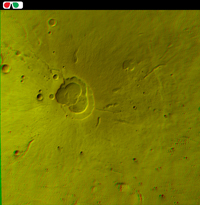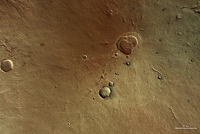Navigation/Menü: Links auf weitere Seiten dieser Website und Banner
01.03.2004
HRSC Bildserie #023 - Hecates Tholus (Orbit 0032)
HRSC Press Release #023 - Hecates Tholus (orbit 0032)
Hecates Tholus ist der nördlichste Vulkan der Elysiumgruppe auf dem Mars und liegt geographisch bei 150 Grad
Ost und 31,7 Grad Nord. Der kesselartige Krater, die so genannte Caldera, ist asymmetrisch und zeigt mehrere
Einstürze durch die Entleerung der darunterliegenden Magmakammer. Auf den Flanken des Vulkans sind mehrere
radialverlaufende Talsysteme, die auf die frühere Existenz von Wasser hindeuten, und Einsturzformen, die auf
Lava hindeuten, zu erkennen. Der Vulkan hat eine Höhe von 5300 Meter, die Caldera besitzt einen Durchmesser
von maximal 10 Kilometer und eine Tiefe von etwa 600 Meter. Die Aufnahme entstand aus einer Höhe von 275
Kilometer und hat eine Auflösung von 12,5 Meter pro Bildpunkt. Aufgrund der besseren Wirkung des 3D-Effekts
ist Norden in diesem Bild rechts. Unten zum Vergleich ein "normales" zweidimensionales Farbbild des Vulkans
Hecates Tholus, das aus derselben Höhe und in derselben Auflösung aufgenommen wurde. Norden ist hier oben.
Die Farbansichten wurden aus dem senkrecht blickenden Nadirkanal und den Farbkanälen erstellt, die Schrägansicht wurde aus den Stereokanälen der HRSC berechnet. Die Anaglyphen werden aus dem Nadirkanal und einem Stereokanal abgeleitet. Die schwarzweißen Detailaufnahmen wurden dem Nadirkanal entnommen, der von allen Kanälen die höchste Auflösung zur Verfügung stellt.
The colour scenes have been derived from the three HRSC-colour channels and the nadir channel. The
perspective views have been calculated from the digital terrain model derived from the
stereo channels. The anaglyph image was calculated from the nadir and one stereo channel.
The black and white high resolution images were derived form the nadir channel which provides the
highest detail of all channels.
Das Kameraexperiment HRSC auf der Mission Mars Express der
Europäischen Weltraumorganisation ESA wird vom Principal Investigator Prof. Dr.
Gerhard Neukum (Freie Universität Berlin), der auch die technische Konzeption der
hochauflösenden Stereokamera entworfen hatte, geleitet. Das
Wissenschaftsteam besteht aus 40 Co-Investigatoren aus 33 Institutionen und zehn
Nationen. Die Kamera wurde am Deutschen Zentrum für Luft- und Raumfahrt (DLR) unter der
Leitung des Principal Investigators (PI) G. Neukum entwickelt und in Kooperation mit
industriellen Partnern gebaut (EADS Astrium, Lewicki Microelectronic GmbH und Jena
-Optronik GmbH). Sie wird vom DLR -Institut für Planetenforschung in Berlin-Adlershof
betrieben. Die systematische Prozessierung der Daten erfolgt am DLR. Die Darstellungen
wurden vom Institut für Geologische Wissenschaften der FU Berlin in Zusammenarbeit
mit dem DLR-Institut für Planetenforschung erstellt.
The High Resolution Stereo Camera (HRSC) experiment on the ESA Mars Express Mission is led by the
Principal Investigator (PI) Prof. Dr. Gerhard Neukum who also designed the camera technically. The
science team of the experiment consists of 40 Co-Investigators from 33 institutions and 10 nations.
The camera was developed at the German
Aerospace Center (DLR) under
the leadership of the PI G. Neukum and built in cooperation with industrial partners (EADS
Astrium, Lewicki Microelectronic GmbH and Jena-Optronik GmbH). The experiment on Mars Express
is operated by the DLR Institute of Planetary Research, through ESA/ESOC. The systematic
processing of the HRSC image data is carried out at DLR. The scenes shown here were created
by the PI-group at the Institute for Geological Sciences of the Freie Universitaet Berlin in
cooperation with the German Aerospace Center (DLR), Institute of Planetary Research, Berlin.
© Copyright: ESA/DLR/FU Berlin (G. Neukum)
Download
 This 3D image of the Hecates Tholus volcano was taken by the High Resolution Stereo Camera (HRSC)
on Mars Express in orbit 32 on 19 January 2004 from an altitude of 275 km. It shows the summit
caldera of Hecates Tholus, the northernmost volcano of the Elysium volcano group. The volcano
shows multiple caldera collapses. On the flanks of Hecates Tholus several flow features related
to water (lines radiating outwards) and pit chains related to lava can be observed. The volcano
has an elevation of 5300 m, the caldera has a diameter of maximum 10 km and a depth of 600 m.
Note that in order to achieve the optimum 3D effect north is on the right.
This colour image of the Hecates Tholus volcano was taken by the High Resolution Stereo Camera (HRSC)
on Mars Express in orbit 32 on from an altitude of 275 km. The image centre is located at 150° East
and 31.7° North. North is at the top.
This 3D image of the Hecates Tholus volcano was taken by the High Resolution Stereo Camera (HRSC)
on Mars Express in orbit 32 on 19 January 2004 from an altitude of 275 km. It shows the summit
caldera of Hecates Tholus, the northernmost volcano of the Elysium volcano group. The volcano
shows multiple caldera collapses. On the flanks of Hecates Tholus several flow features related
to water (lines radiating outwards) and pit chains related to lava can be observed. The volcano
has an elevation of 5300 m, the caldera has a diameter of maximum 10 km and a depth of 600 m.
Note that in order to achieve the optimum 3D effect north is on the right.
This colour image of the Hecates Tholus volcano was taken by the High Resolution Stereo Camera (HRSC)
on Mars Express in orbit 32 on from an altitude of 275 km. The image centre is located at 150° East
and 31.7° North. North is at the top.
hochaufgelöste Bilddaten / full resolution image data
Nadiraufnahme / Grayscale Nadir Image download TIF (24.7 MB) Rot-Cyan Anaglyphe / Red-cyan anaglyphe download TIF (12.4 MB)

 Deutsch
Deutsch


